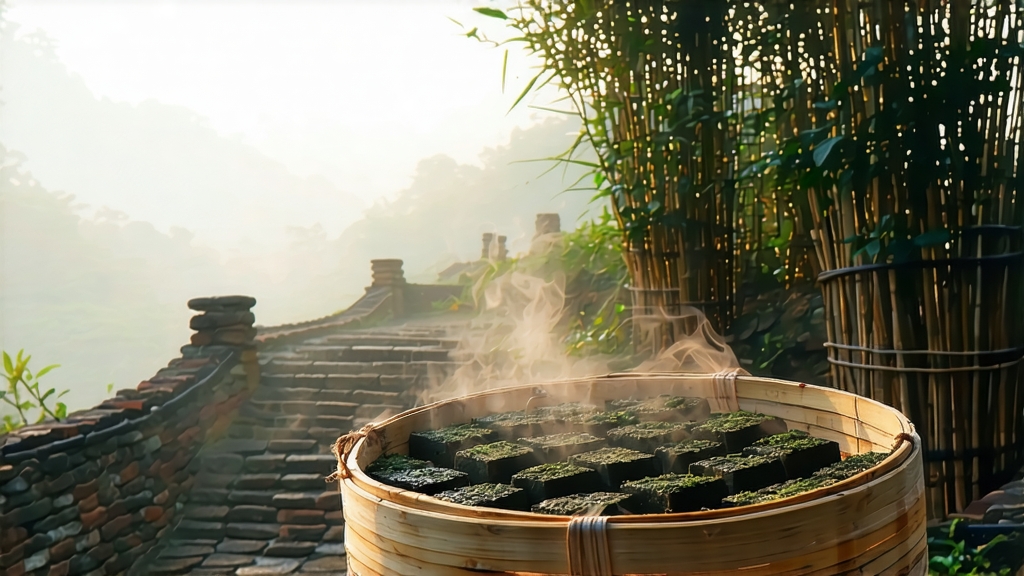
Tucked away in the southern foothills of the Dayao Mountains, where warm mist drifts above the Liu River, Liupao dark tea has quietly matured for more than 1,500 years. Unlike its more famous cousins—Anhua Fu Brick or Yunnan Pu-erh—Liupao never sought the spotlight. It was carried by porters along the ancient Tea-Horse Road’s southern branch, traded for medicinal herbs, and stored in the rafters of Dong and Yao minority homes, absorbing the scent of wood smoke and subtropical orchids. Today, as global palates search for deeper, earthier flavors and gut-friendly beverages, Liupao is stepping out of the shadows, offering a story of resilience, microbial alchemy, and mountain terroir that can be tasted in every amber cup.
Historical Footprints
The first written record appears in the Qing dynasty “Chronicles of Cangwu County” (1717), noting that “the Liu River boats sail heavy with dark tea, sought by Malay herbalists for cooling the blood.” By the late 19th century, Liupao was compressed into 36-kilogram bamboo baskets, steam-softened, then loaded onto junks bound for Hong Kong and Singapore, where dock workers coined the term “coolie tea” because a bowl settled stomachs after a night of rice-wine revelry. During the Second World War, Japanese blockades cut off Indian tea to Southeast Asia; Liupao filled the vacuum, and its reputation as a digestive tonic spread among Nanyang Chinese communities. When the Cultural Revolution shuttered private workshops, mountain villagers kept micro-fermentation alive in earthen jars buried under pigsties, saving the fungal strains that modern labs now identify as Eurotium cristatum and Aspergillus niger—cousins of the “golden flower” spores prized in Fu Brick.
Micro-Terroir and Leaf Architecture
Authentic Liupao can only be produced in the 30-km radius around Liubao town, Wuzhou City, Guangxi Zhuang Autonomous Region. The area sits on red lateritic soil rich in iron and potassium, while the Liu River’s daily temperature swing of 8–10 °C creates a natural “breathing” cycle for piled leaves. The cultivar of choice is the local “Yuntai Large-Leaf,” a Camellia sinensis var. assamica descendant whose leaves can reach 25 cm in length and 10 cm in width—broad enough to hold the spores that will later bloom inside the stem veins. Spring harvest is preferred; farmers pick one bud with three or four leaves, allowing the tougher third and fourth leaves—the “lao ye” (old grandfather)—to provide the cellulose that fuels post-fermentation.
Crafting the Darkness: A Two-Stage Fermentation
Liupao’s hallmark is its “double fermentation,” a technique recognized as national intangible cultural heritage since 2014.
Stage 1: Pile Fermentation
After a brief outdoor withering under subtropical sun, leaves are wok-fired at 280 °C for eight minutes—just long enough to kill green enzymes while preserving leaf integrity. They are then piled 70 cm high inside pine-lined chambers kept at 28 °C and 85 % humidity. Every 48 hours the pile is turned, sprayed with tiny amounts of Liu River water, and “foot-tamped” by workers wearing bamboo-fiber socks that prevent compaction while adding trace yeasts from the skin’s microbiome. After 25–30 days the leaves turn chestnut-brown and emit a scent reminiscent of damp jujube and betel nut.
Stage 2: Bamboo-Basket Aging
The partially fermented maocha is steamed again, stuffed into 1-meter-long bamboo cylinders lined with wild taro leaves, and compressed by stepping—an echo of wine-grape treading. The baskets are then slid into limestone caves whose relative humidity hovers at 90 %. Over the next three to fifteen years, slow oxidation and microbial action continue; periodic “re-steaming” every five years re-activates enzymes, allowing the tea to darken further without becoming musty. The result is a leaf that gleams with a subtle bronze frost, and a liquor that tastes of molasses, longan, and river stone.
Grades and Styling
Liupao is sold both loose and compressed. Traditional basket tea, called “Lang,” comes in 37 kg, 20 kg, 5 kg, and 1 kg sizes; the smaller the basket, the faster the aging. Modern mini-br